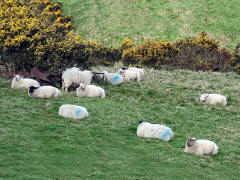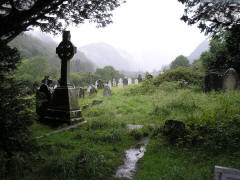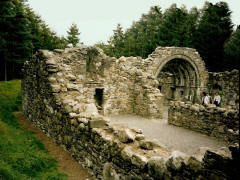|
REPUBLIC OF IRELAND
Saturday, 15 September
(continued). After
spending 2 1/2 hours touring the City of
Dublin, about 1:00 p.m. our bus finally headed southeast toward the coast road
to Gledalough in County Wicklow, one of Ireland's most
scenic counties. On our way
south out of Dublin. we drove through Donneybrook, once
notorious for drunken and violent disorder at its annual
fair, giving rise to the term "donnybrook." We were soon
on the N11 expressway near (but not on) the coast. The
scenery was strictly rural and very green.
We past many sheep in the fields. They were "branded" with blotches of dye to mark ownership. Soon there were mountains to the west, and we passed close to Little Sugar Loaf Mountain on our east. After passing the town of Wicklow, we turned off the highway and followed narrow country roads to the small village of Avoca. Our destination was actually the Avoca Mill outside the village. We arrived a little before 2:00 and had half an hour on our own. This is said to be the oldest wool mill in Ireland (1723). They had beautiful sweaters and other items for sale, but the prices were steep and the clothing is probably too warm for American homes. The bus then took us to the Woodenbridge Inn in the town of Arklow for a three course lunch. We could see Great Sugar Loaf Mountain in the distance as we rode. We left Arklow about 3:30 and drove to Glendalough, passing through through the small village of Rathdrum. We arrived about 4:15.
Glendalough (Valley of Two Lakes) is a glacial
valley in County Wicklow renowned for its medieval
monastic settlement. The settlement was founded in the 6th century by St
Kevin, a hermit priest. Much of itt was destroyed by
English troops in 1398. It was finally abandoned during
the Dissolution of the Monasteries in 1539, but pilgrims
continued to come to the site. In its heyday the monastery included
workshops, areas for manuscript production, guest
houses, an infirmary, farm buildings and dwellings for
both the monks and a large lay population. The surviving
buildings date from between the 10th and 12th centuries.
A lot of restoration work was done in the 1870s.
Much of the grounds was occupied by
interesting old tombstones, but our guide pointed out
that these were not from the original abbey; they were
added after the monastery was abandoned, apparently
because people wanted to be buried in what was
considered especially holy ground. Some
of the stones were from as late as the 20th century.
The largest remaining ruin on the grounds is the Cathedral (about 1200), but only the shell of the nave is left. There are ruins of several other small churches as well, consisting mostly of a few crumbling walls. The most interesting and best preserved (or restored) of the old churches is St. Kevin's Church, situated down a hill from the tower and the main ruins. It has a very unusual stone roof. Such roofs have no underlying supports, other than the semi-circular vaulted ceiling below; they rely for support on the careful overlapping of the stones.
We got to the ship at 6:50. We'd had a large meal for lunch at 2:30 so, after a short stop at our room, we went out on the Lido deck for a (relatively) light snack. The temperature was in the mid-50s and this was about the first time it was warm enough to sit out there. We were back in our cabin when the ship sailed at 8:30.
Copyright © 2000-2023 DarrellPeck.com All rights
reserved. | ||||||








